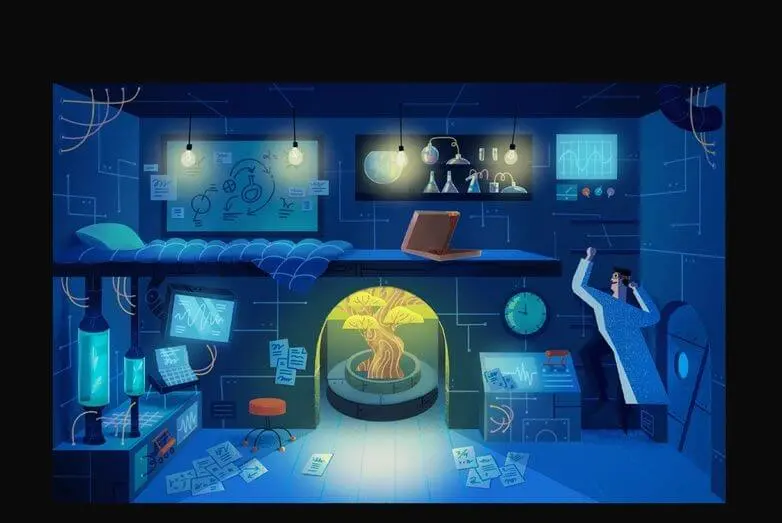16 Types of Animation Techniques in Multimedia to Elevate Your Motion Skills

Multimedia technologies are a set of means and methods of promoting brands. Animation design today is one of the most favorite technologies. There are different techniques for animations to create cartoons or animated video for business. Most animators know the 12 animation techniques outlined by Disney animators Frank Thomas and Ollie Johnston back in 1981. Now, these principles are accomplished and updated with some more principles. Let’s revise the classics, as well as view four extra animation methods.
1) Squash and Stretch
Squash and Stretch were Disney’s basic animation techniques and most important discoveries. It’s about the fact that during the movement of a living body with each step (as with any action) it contracts, then stretches, then expands, then lengthens again, etc. The outline of such a character is breathing, which creates an effect of a living object because all parts of the character organically move. Nevertheless, it is practically not used by animators creating modern computer games.
2) Anticipation
Before making any sudden movement or physical action, a person usually needs preliminary preparation – as if anticipating the action.
For example, before jumping up they squat, before jumping long they step back, etc. Such a preparatory movement is always made in the opposite direction to the intended one, therefore it is called anticipation: the character seems to first give up the intention in order to carry it out more successfully.
The viewer must be prepared for each subsequent movement of the character and expect it even before it will happen. This is achieved by anticipating each major movement with a specific gesture or movement that sets the viewer in tune with what is about to happen.
3) Staging
Staging is the most general principle, referring to the history of theatre. The stage action is always designed for an external observer, for a spectator watching what is happening. Therefore, it strives to ensure that everything is extremely clear, understandable, and recognizable. A facial expression is scenic if it is well readable; the mood of a character is scenic if it affects the viewer. The character of the character should be recognizable, the details should be clearly visible, the replicas should be legible, the text should be intelligible, etc.
4) Straight Ahead Action & Pose to Pose
The layout work was invented at the Disney studio. Prior to this, the animators had simply phased straight ahead starting with the first movement of the characters in the scene, a drawing after drawing in succession, coming up with something as they went until finishing the scene. In this case, the animators knew the storyline, but they did not have a very clear idea of how it would all look at the end.
When working with layouts pose to pose, the action is clear and tense, and with straight-ahead – great spontaneity, sketchiness, lightness may be achieved. Often the latter approach is more effective rather than over-planning because it introduces an element of surprise and spontaneity.
5) Follow Through
Alongside Overlapping Action, these animation methods are used to give the movement more naturalness, plasticity, and continuity. A movement must never completely stop before the next movement has begun. The movement and overlap ensure the continuity of the narrative and the consistency of individual episodes.
6) Slow In & Slow Out
When developing layouts, the animator seeks their maximum expressiveness and, naturally, wants to focus the viewer’s attention on them. To do this, the movement from one layout to another is calculated in such a way, so that the bulk of the time falls on the demonstration of the layouts.
7) Arcs
Living organisms rarely move up and down or back and forth with mechanical precision. The head, for example, is rarely drawn immediately forward and then immediately back; it also rises or falls slightly. The Woodpecker movement is one of the rare exceptions.
That’s why the discovery of arc-type movement has made a real revolution in animation. Even when moving along a straight line, the object undergoes a rotation. Through movement, finishing, and overlap often acquire an arc character. When this principle of movement was accepted, all phases began to be placed along arc trajectories.
8) Secondary Action
The absence of additional actions leads to the schematization of characters, their transformation into functional robots. Random, unplanned small movements of the character or changes in his facial expression, sighs, short remarks immediately give personality to the hero and distinguish him from other characters.
9) Timing
The right timing is a key moment for the right perception of on-screen images by the viewer.
Timing in animation is determining the interval between actions to emphasize the weight, size, and character of the personage. The number of phases used for any movement determines how long the action will take on the screen. When calculating the time, the weight and size of the object, as well as its internal state, are taken into account.
10) Exaggeration
In animation, the exaggerated things speak volumes – the animator emphasizes the main features, highlights the essence of any object so that the audience perceives it another way.
Animation images are characterized by influences in the range of weak emotions (interest, lyrics, and shame). With the help of exaggeration, an increase in emotional impact is achieved to a certain extent.
11) Solid drawing
Image drawing should be qualified and solid. After all, drawing in animation is important as an element of a moving image. So, master painting with great typography is preferred during creation of whiteboard animation or doodles, making up character sketches for the games, and so on.
12) Appeal
Any object can be attractive if you look at it with pleasure, discovering charm, simplicity, strong design, 2d animation techniques, clarity and attractiveness, charm and magnetism, etc.
It’s wise not to overdo here with the scene because if the animator tries to convey too subtle shades in the character’s facial expression, for instance, the drawing can become poorly perceived and produce a wrong impression.
13) Shape Tweening
Let’s say you want a square to smoothly turn into a circle, or a rabbit silhouette to smoothly flow into a wolf silhouette. In these cases, the shape tweening is used as one of the animation techniques in multimedia.
As usual, you set two keyframes some distance apart. This animation option has a hard limitation: your animation must occupy a separate layer and be a single drawn figure (there should be no groups or symbols).
Animation based on symbol changes (Motion tweening) is the most commonly used animation option is motion animation. In this case, the animation is based on the modification of characters, i.e. the animation object is a character. Like the shape tweening animation, each object requires one layer at a time. This layer should contain one symbol, with which all changes will occur.
14) Strong Design
It’s an easy animation techniques that makes sure the characters are built from simple shapes such as spheres, cylinders and boxes, all to ensure that the designed model remains at the core of the design throughout the whole video production.
15) Shot Types
Incorrect placement of models and camera shot types results in a banal shot, boring animation, and uninteresting screen views. Proper mise-en-scène connects the character with story elements and is visually interesting. In the right frame, we see the little character having a hard time convincing his friends; on the frame on the left it is not clear what is happening.
16) Acting & Pantomime
Animated acting has much in common with the pantomime or buffoonery of the silent film era. Buster Keaton, Harold Lloyd and Chaplin are great examples. Clear poses better convey the emotions and experiences of the characters while applying different animation techniques.
All principles depicted are found on YouTube.

Do you want to create your own video? – Feel free to contact us!
Suppose you want to discover the world of animated video for business and learn more about the digital marketing animation video. In that case, you are always welcome to visit one of the leading video production studios and ask the team. We have been producing animation to help companies transfer their message to customers, spice up an online presence, and stand out from competitors, constantly improving and updating the toolkit. Here you will be more likely to receive the most up-to-date expertise and needed support for your projects.
Conclusion
Since multimedia technologies are growing for promoting goods and services with the help of motion design, there are the basic animation techniques applied and some new methods emerging to meet the modern animation design needs.
There are also many programs for creating cartoons. Different techniques of animations and different versions of programs allow you to create animated characters in various designs, etc. The most important is the expertise from the leading studios you may always get to create your projects and the basic knowledge you may get alongside. Feel free to use it to the fullest.


